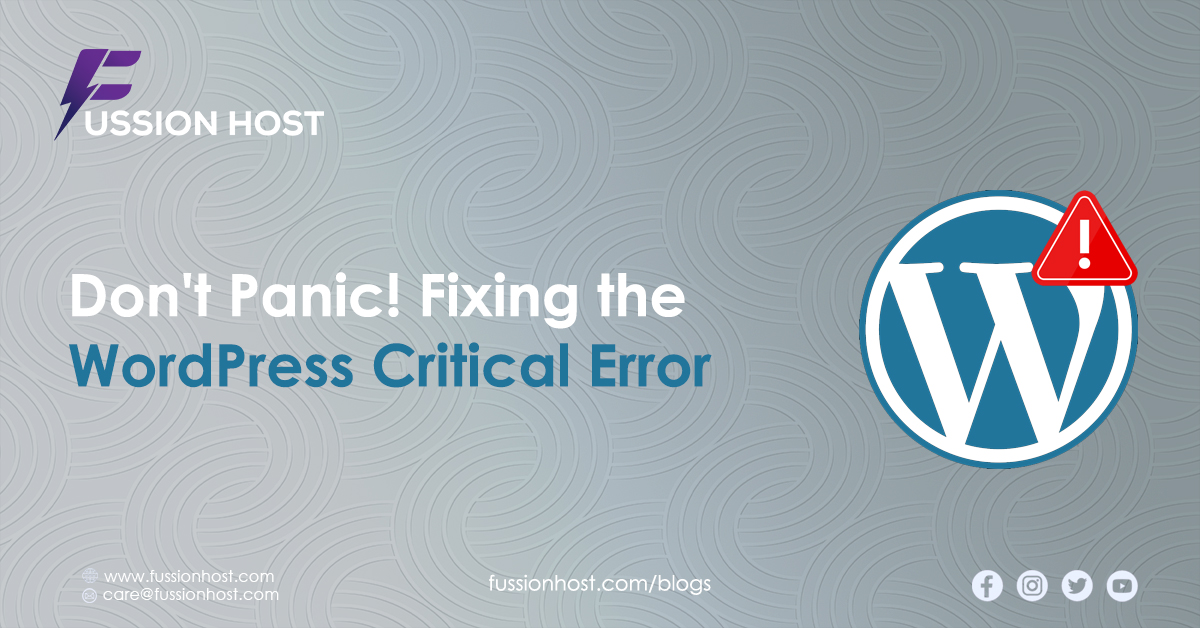
Understanding and Fixing the WordPress Critical Error
Have you ever encountered a frustrating blank screen while visiting your WordPress website, accompanied by the ominous message “There has been a critical error on this website”? Fear not, for you’re not alone. This error, often called the WordPress Critical Error or White Screen of Death (WSoD), can leave even seasoned website owners scratching. But worry not, for this article equips you with the knowledge and tools to combat this foe and get your website back on track.
Understanding the WordPress Critical Error
The Critical Error arises when a fatal error occurs within the core WordPress files, themes, or plugins, preventing your website from functioning properly. Imagine WordPress as a complex machine with many interconnected parts. If one cog malfunctions, the entire machine grinds to a halt. This error can be caused by various factors, including:
- Conflicting Plugins: Plugins with overlapping functionalities can sometimes clash, causing errors.
- Corrupted Theme Files: A corrupted theme file can disrupt how WordPress displays your website.
- Memory Limit Reached: If your website uses many resources, it might exceed the allocated memory limit, triggering an error.
- Outdated PHP Version: An outdated PHP version, the programming language powering WordPress, might have compatibility issues with your theme or plugins.
- Database Corruption: In rare cases, corruption within your WordPress database can lead to critical errors.
Conquering the WordPress Critical Error: A Step-by-Step Guide
While the Critical Error might seem daunting, fret not, for solutions exist! Here’s a step-by-step guide to help you diagnose and fix the issue:
1: Check for Admin Email Notification:
In its infinite wisdom, WordPress often sends an email notification to your admin email address containing details about the error, including the problematic line of code. This can be a goldmine of information, pinpointing the exact cause of the error. Check your spam folder if you don’t see it in your inbox.
2: Accessing Your Website’s Files (FTP or File Manager):
Since the error might prevent you from accessing the WordPress admin area, we’ll need to access your website’s files directly. This can be done through two methods:
- File Transfer Protocol (FTP): Use an FTP client like FileZilla to connect to your web hosting server and navigate to your WordPress files.
- File Manager: Many web hosting providers offer a tool within their control panel that allows you to access and edit your website’s files directly through your web browser.
3: Deactivating Plugins (The Root Cause Detective):
Plugins are a common culprit behind Critical Errors. Here’s how to systematically identify and deactivate the problematic plugin:
- Locate the wp-content/plugins folder within your website’s files.
- Rename the plugins folder to something like plugins. Old. This effectively deactivates all plugins at once.
- Try reaccessing your website. If the error is resolved, you’ve identified plugins as the culprit.
4: Isolating the Problematic Plugin (Divide and Conquer):
Now that you know plugins are causing the issue, let’s isolate the specific culprit:
- Rename the plugins. Old folder back to plugins.
- Access your website’s files again through FTP or File Manager.
- Inside the plugins folder, rename individual plugin folders individually (e.g., plugin-name to plugin-name. old).
- After renaming each plugin folder, try accessing your website. Once the error reappears, you’ve identified the problematic plugin. You can either deactivate or replace it with a compatible alternative.
5: Revert to Default Theme (Is it the Outfit?):
A corrupted theme file can also trigger a Critical Error. Here’s how to test if your theme is the culprit:
- Access your website’s files through FTP or File Manager.
- Navigate to the wp-content/themes folder.
- Identify your currently active theme folder (usually the one with a different name than the others).
- Rename your active theme folder to something like theme-name. Old. WordPress will automatically switch to the default theme.
- Try reaccessing your website. If the error is resolved, your theme might be causing the issue. You can reinstall the theme or switch to a different one.
6: Increase PHP Memory Limit (Giving WordPress More Room to Breathe):
Sometimes, a Critical Error arises because WordPress runs out of memory your web hosting provider allocates. Here’s how to increase the PHP memory limit:
- Locate the wp-config.php file within your WordPress root directory (usually the public_html folder).
- Open the file in a text editor and look for a line similar to the one defined (‘WP_MEMORY_LIMIT’, ‘256M’). This line represents the current memory limit.
- If the line is absent, add a value slightly higher than the current limit (e.g., define(‘WP_MEMORY_LIMIT’, ‘512M’);). Avoid setting it unreasonably high, as it can impact server performance.
- Save the changes to the wp-config.php file and upload it back to your server.
- Try reaccessing your website. An increased memory limit might resolve the error if resource limitations were the culprit.
7: Check for Database Corruption (For the Technically Adept):
Database corruption, though less frequent, can also cause Critical Errors. However, this fix involves modifying your database and is recommended for users comfortable with database management. If you need more clarification, seek help from your web hosting provider or a WordPress developer.
8: Reinstall WordPress (The Nuclear Option):
If none of the previous solutions works, a last resort is to reinstall WordPress. This will erase all themes, plugins, and content, so ensure a complete backup before proceeding. Most web hosting providers offer a one-click WordPress reinstall option within their control panel.
Remember: Before attempting any reinstall, create a full backup of your website’s files and database. This allows you to restore your website to its previous state if something goes wrong during troubleshooting.
Beyond the Fix: Preventing Future WordPress Critical Errors
While we’ve tackled fixing the Critical Error, here are some proactive steps to minimize its future occurrence:
- Maintain Updated WordPress Core, Themes, and Plugins: Regularly update WordPress themes and plugins to ensure compatibility and address potential security vulnerabilities.
- Limit Plugin Usage: Only install and activate plugins essential for your website’s functionality. Deactivate and delete unused plugins to avoid conflicts.
- Choose Reputable Plugins: Stick to well-established and developer-supported plugins to minimize compatibility issues.
- Regular Backups: Create regular backups of your website’s files and database. This allows you to restore your website quickly in case of errors or unforeseen circumstances.
- Monitor Error Logs: Enable WordPress error logging to identify potential issues before they snowball into critical mistakes.
Conclusion
Though disruptive, the WordPress Critical Error is not an insurmountable foe. By following this guide and adopting preventative measures, you can effectively troubleshoot and prevent future occurrences. Remember, a calm approach, detective work, and a willingness to explore solutions are your allies in conquering this challenge and keeping your WordPress website running smoothly.



Leave a Reply